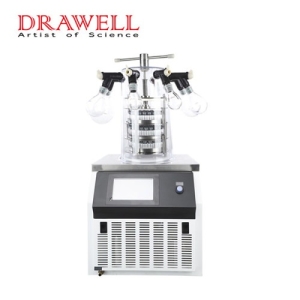With these questions in mind, we are going to write a series of articles about the apparatus used in tissue culture laboratories as well as how they perform their functions. You are going to acquire a comprehensive understanding of autoclaves, including their functions and applications, by the time you have finished reading this article. So, let's dig in!
WHAT IS AN AUTOCLAVE?
The autoclave, which can also be referred to as a steam sterilizer, is the piece of machinery that is the most efficient at sterilizing laboratory equipment, water, or media. The machine employs the use of pressurized steam in order to eradicate any bacteria, viruses, or spores that may be present in or on the culture media or the equipment. In addition to industrial settings, scientific laboratories and medical facilities all make use of it.
Charles Chamberland is credited with the invention of the autoclave in the year 1879. In contrast, Robert Koch presented the ideas of disinfection and sterilization for the first time in the year 1881. Then, in 1933, the modern autoclave was developed. It was the first pressure steam sterilizer with control performance.
PRINCIPLE OF AUTOCLAVE
The sterilization process utilized by the autoclave is based on the concept of moist heat. The high pressure inside the chamber raises the temperature of the water to a point where it can sterilize the equipment more effectively. The higher pressure also ensures that heat will quickly penetrate the deeper parts of the apparatus as quickly as possible. The presence of moisture in the steam causes the proteins of microbes to coagulate, which results in an irreversible loss of activity and function in the microbes.
HOW DOES AUTOCLAVE WORK?
The sterilization process in an autoclave goes through three iterative phases, which are described in the following order regardless of the size of the autoclave:
During this phase, any air that may be present in the hermetically sealed chamber is expelled using steam that is introduced via the sterilizer.
The exhaust valve is closed at the beginning of the exposure phase. During this phase, the temperature and pressure inside the hermetically sealed chamber are brought up to the desired set point. The temperature is kept at the same level for the allotted amount of time.
Exhaust phase: the exhaust valve is opened, steam is evacuated, and the temperature inside the chamber is brought back down to normal.
AUTOCLAVE'S COMPONENTS AND THE FUNCTIONS THAT THEY PLAY
1. PRESSURE CHAMBER
The autoclave's primary working component is known as the pressure chamber. It features an interior space in addition to an exterior covering. In most cases, the iron case is used to construct the outer chamber, while stainless steel or gunmetal is used to construct the inner chamber.
The autoclaves used in the hospitals and laboratories are equipped with a jacketed chamber that is filled with steam. This chamber is designed to cut down on the amount of time needed for the sterilization cycle. These vertical autoclave come in capacities ranging from 100 liters to three thousand liters. As a result, you are free to acquire the device in accordance with your specifications.
2. Lid/Door
To achieve the desired temperature and pressure inside the autoclave, the lid must be closed, the chamber must be cut off from the surrounding air, and the autoclave must be hermetically sealed. The pressure gauge, the whistle, and the safety valve are the three additional components that make up this item.
The pressure gauge not only ensures that the machine and the working conditions are safe, but it also displays the pressure that has built up inside the autoclave. The whistle that is included with the autoclave is identical to the whistle that is found on standard domestic pressure cookers. It does this by letting out a predetermined quantity of vapor, which in turn regulates the pressure inside the chamber.
The autoclave's safety valve is an additional important component of the device. In the event that the autoclave is unable to carry out its functions, it has a very thin layer of rubber that will rupture, allowing the pressure inside the chamber to be released. It protects you from the possibility of an explosion caused by an autoclave.
3. a generator that produces steam (if it is applicable)
Within the chamber, there is a steam generator that can be found. The chamber is equipped with an electric heating system that raises the temperature of the water to produce steam. Always make sure that the generator has the appropriate amount of water in it in order to keep the process running smoothly and prevent the autoclave parts from overheating or burning.
4. Vacuum generator (if applicable)
Because the presence of any air pockets in the chamber might support the growth of any organism, this removes all of the air from the chamber. Without this step, your equipment will not be sterilized.
5. A device for cooling waste water
Before the effluent (air, steam, and condensate) enters the draining pipes, are fitted with a waste-water cooler that brings the temperature down to a more manageable level. It prevents the damage to the draining pipes that can be caused by water that has been heated to very high temperatures.
DIFFERENT KINDS OF AUTOCLAVES
There are numerous variations of high pressure autoclave available to meet your requirements in today's market. This includes the following:
Domestic pressure cookers of the pressure cooker type/laboratory bench (N-type): This type of autoclave is ideal for tissue culture enthusiasts or hobbyists because it is a pressure cooker.
The gravity displacement type autoclave is the type of autoclave that is used in research laboratories more frequently than any other type. Using the force of gravity and a drain port, steam is forced into the chamber of this autoclave, displacing the air there.
The positive pressure displacement type, also known as the B-type, is an advanced autoclave that sterilizes equipment by first producing steam in a separate steam generator and then directing that steam into the autoclave itself. This process is known as the positive pressure displacement type.
The autoclave known as the negative pressure displacement type, also known as the S-type, is the most expensive type. It comes equipped with a vacuum generator as well as a steam generator, both of which operate effectively to ensure that the equipment is thoroughly sterilized.
BE PRECAUTIOUS WHILE USING AUTOCLAVES
Do not attempt to sterilize substances that are watertight or resistant to water, such as oil or powder.
Take care not to jam too many vessels and pieces of equipment into the autoclave. If it's at all possible, you should sterilize your equipment in a clockwise direction.
When autoclaving waste from packages, autoclavable bags should be used exclusively.
Use autoclavable bags to sterilize your equipment. Do not use aluminum foils.
Do not fill the chamber of the autoclave all the way to the top.
Under no circumstances should you make an attempt to open the autoclave while it is running.
To ensure that the autoclave is properly closed and ready for sterilization, ensure that the lid is securely fastened before beginning the process.
In the autoclave, you must not utilize any regular plastics or trays.
Never put anything combustible, reactive, corrosive, toxic, or radioactive in an autoclave. This includes household bleach and tissue that has been embedded with paraffin.
Put enough water into the steam generator so that it reaches the point where it touches the end of the chamber or the vessel that the autoclave is housed in.
The information that follows is succinct and to the point, and it pertains to autoclaves. It is always preferable to understand the use and principle of the equipment you are working with in order to have a better understanding of the science that lies behind it. And the process behind it. In addition, you are aware of the problem in the event that it arises!
menu
menu
Menu
close
- homeHome
- arrow_backarrow_drop_downaccount_circlePeople
- arrow_backarrow_drop_downchatChat Time
- arrow_backarrow_drop_downvideocamMeetings
- Go Live
- arrow_backarrow_drop_downGift card & Top ups
- arrow_backarrow_drop_downnewspaperNews
- arrow_backarrow_drop_downbusinessProperties
- arrow_backarrow_drop_downwork_historyJobs Search Engine
- arrow_backarrow_drop_downstorefrontStores
- arrow_backarrow_drop_downlibrary_musicMusics
- arrow_backarrow_drop_downMore


